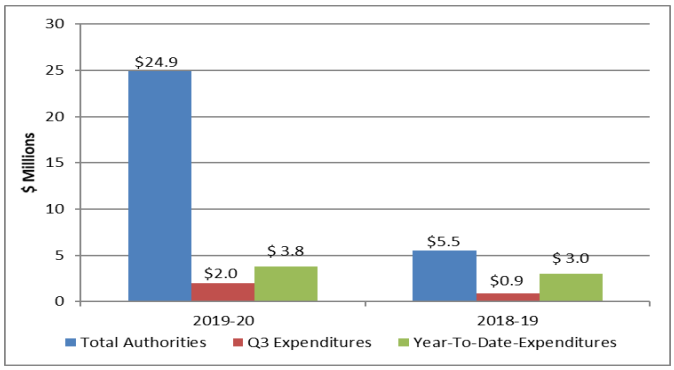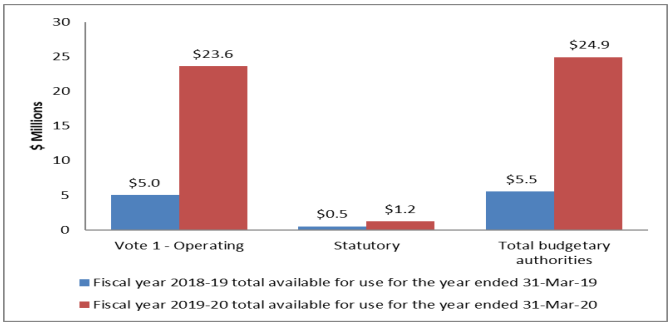Date of Publishing:
Introduction
This quarterly report has been prepared by management as required by section 65.1 of the Financial Administration Act and in the form and manner prescribed by the Directive on Accounting Standards, GC 4400 Departmental Quarterly Financial Report. This quarterly financial report should be read in conjunction with the 2019-20 Main Estimates.
A summary description of the National Security and Intelligence Review Agency Secretariat (NSIRA) program activities can be found in Part II of the Main Estimates. For information on the mandate of NSIRA, please visit its website at http://www.nsira-ossnr.gc.ca.
This quarterly report has not been subject to an external audit or review.
Mandate
On June 21, 2019 the National Security and Intelligence Review Agency Act (NSIRA Act) received Royal Assent. This new legislation, which came into force on July 12, 2019, significantly enhances national security accountability in Canada. NSIRA has a statutory mandate to review the activities of the Canadian Security Intelligence Service (CSIS) and of the Communications Security Establishment (CSE), as well as the national security and intelligence activities of all other federal governement departments and agencies. The NSIRA replaces the Security Intelligence Review Committee (SIRC), which reviewed CSIS’s activites and it also replaces the Office of the CSE Commissioner (OCSEC), which reviewed CSE’s activities.
In addition, NSIRA inherited the complaints investigation functions of the Security Intelligence
Review Committee (SIRC), which was responsible for hearing complaints from members of the
public regarding the actions of CSIS, as well as those related to the revocation or denial of
security clearances. Going forward, NSIRA will also hear complaints regarding the CSE, as well
as national security-related complaints regarding the RCMP.
The NSIRA will report its findings and recommendations on an annual basis to Parliament with
its first annual public report planned to be tabled in 2020. The NSIRA is also required to produce
an annual report for Parliament on the disclosure of information under the Security of Canada
Information Disclosure Act.
Basis of presentation
This quarterly report has been prepared by management using an expenditure basis of accounting. The accompanying Statement of Authorities includes the department’s spending authorities granted by Parliament and those used by the department, consistent with the 2019- 20 Main Estimates as well as the Supplementary Estimates (A) and Treasury Board (TB) Central Votes. This quarterly report has been prepared using a special purpose financial reporting framework (cash basis) designed to meet financial information needs with respect to the use of spending authorities.
The authority of Parliament is required before moneys can be spent by the Government. Approvals are given in the form of annually approved limits through appropriation acts or through legislation in the form of statutory spending authority for specific purposes.
When Parliament is dissolved for the purposes of a general election, section 30 of the Financial Administration Act authorizes the Governor General, under certain conditions, to issue a special warrant authorizing the Government to withdraw funds from the Consolidated Revenue Fund. A special warrant is deemed to be an appropriation for the fiscal year in which it is issued.
Highlights of the fiscal quarter and fiscal year-to-date results
This section highlights the significant items that contributed to the net increase or decrease in
authorities available for the year and actual expenditures for the quarter ended December 31,
2019.
NSIRA spent approximately 15% of its authorities by the end of the third quarter, compared to
55% in the same quarter of 2018-19 (see graph 1 below).
Graph 1: Comparison of total authorities and total net budgetary expenditures, Q3 2019–20 and Q3 2018–19

Text version of Figure 1
| 2019-20 | 2018-19 | |
|---|---|---|
| Total Authorities | $24.9 | $5.5 |
| Q3 Expenditures | $2.0 | $0.9 |
| Year-To-Date Expenditures | $3.8 | $3.0 |
Significant changes to authorities
As per graph 2 below as at December 31, 2019, NSIRA has authorities available for use of $24.9 million in 2019-20 compared to $5.5 million as of December 31, 2018, for a net increase of $19.4 million or 353%.
Graph 2: Variance in authorities as at December 31, 2019

Text version of Figure 2
| Fiscal year 2018-19 total available for use for the year ended March 31, 2019 | Fiscal year 2019-20 total available for use for the year ended March 31, 2020 | |
|---|---|---|
| Vote 1 – Operating | $5.0 | $23.6 |
| Statutory | $0.5 | $1.2 |
| Total budgetary authorities | $5.5 | $24.9 |
The authorities increase of $19.4 million is explained by the approval, through Supplementary Estimates, of funding for the mandate of NSIRA.
Significant changes to quarter expenditures
The third quarter expenditures totaled $2.0M for an increase of $1.1M when compared to $0.9M spent during the same period in 2018-19. Table 1 below presents budgetary expenditures by standard object.
Table 1
(in thousands of dollars)
| Material Variances to Expenditures by Standard Object | Fiscal year 2019-20 Expended during the quarter ended December 31, 2019 | Fiscal year 2018-19 Expended during the quarter ended December 31, 2018 | Variance $ | Variance % |
|---|---|---|---|---|
| Personnel | 1,504 | 684 | 820 | 120% |
| Transportation and communications | 99 | 46 | 53 | 115% |
| Information | 3 | 0 | 3 | 0% |
| Professional and special services | 377 | 49 | 328 | 669% |
| Rentals | 4 | 27 | (23) | (85%) |
| Repair and maintenance | 47 | 46 | 1 | 2% |
| Utilities, materials and supplies | 14 | 11 | 3 | 27% |
| Acquisition of machinery and equipment | 6 | 29 | (23) | (79%) |
| Other subsidies and payment | (68) | (29) | (39) | 134% |
| Total gross budgetary expenditures | 1,985 | 863 | 1,122 | 130% |
Personnel
The increase of $820,000 is mainly related to staffing to support new departmental mandate.
Transportation and communications
The increase of $53,000 is mainly explained by higher travel expenditures in support of NSIRA’s expanded mandate.
Professional and special services
The increase of $328,000 is mainly due to the timing of the invoices for Financial Management Services.
Rentals
The decrease of $23,000 is mostly explained by the acquisition of Software licenses in 2018-19.
Acquisition of machinery and equipment
The decrease of $23,000 is mainly explained by furniture acquisitions in 2018-19 in preparation for the creation of NSIRA.
Other Subsidies and payments
The decrease of $39,000 is mostly due to elevated recoveries of salary overpayments processed in the third quarter of 2019-20.
Significant changes to quarter expenditures
The year-to-date expenditures totaled $3.8M for an increase of $0.8M when compared to $3.0M spent during the same period in 2018-19. Table 2 below presents budgetary expenditures by standard object.
Table 2
(in thousands of dollars)
| Material Variances to Expenditures by Standard Object | YTD Expenditures as of December 30, 2019 | YTD Expenditures as of December 30, 2018 | Variance $ | Variance % |
|---|---|---|---|---|
| Personnel | 2,814 | 2,267 | 547 | 24% |
| Transportation and communications | 184 | 187 | (3) | (2%) |
| Information | 7 | 28 | (21) | (75%) |
| Professional and special services | 555 | 229 | 326 | 142% |
| Rentals | 43 | 50 | (7) | (14%) |
| Repair and maintenance | 53 | 64 | (11) | (17%) |
| Utilities, materials and supplies | 20 | 14 | 6 | 43% |
| Acquisition of machinery and equipment | 35 | 142 | (107) | (75%) |
| Other subsidies and payment | 76 | 20 | 56 | 280% |
| Total gross budgetary expenditures | 3,787 | 3,001 | 786 | 26% |
Personnel
The increase of $547,000 is mainly explained by the staffing actions in support of NSIRA expanded operations.
Information
The decrease of $21,000 is mainly related to the earlier production of the SIRC Annual Report in June 2018.
Professional and special services
The increase of $326,000 is mainly explained by the timing of the invoices in 2019-20.
Acquisition of machinery and equipment
The decrease of $107,000 is mostly due to the Network Infrastructure upgrade project that was completed in 2018-19
Other Subsidies and payments
The increase of $56,000 is mainly explained by growth in the payroll system overpayments in 2019-20.
Risks and uncertainties
The ability to hire a sufficient number of qualified personnel within relevant timelines remains a short- and medium-term risk for NSIRA, particularly given the specialized knowledge and skillsets required for many positions. This is further compounded by the requirement for candidates to obtain a Top Secret security clearance, which can incur significant delays.
The ability to expand into additional secure accommodations in a timely manner is also a significant risk for NSIRA, given that its mandate requires it to operate within a high security zone. A lack of secure accommodations would negatively impact the ability of NSIRA to hire large numbers of staff, impeding its ability to deliver on its mandate.
The ability of NSIRA to access the information it needs to do its work and speak to the relevant internal stakeholders to understand policies, operations and ongoing issues is closely tied to the reviewed departments’ capacity to respond to the demands of NSIRA. The resource constraints of the reviewed departments could delay NSIRA’s ability to deliver on its mandate in a timely way.
NSIRA is closely monitoring pay transactions to identify and address over and under payments in a timely manner and continues to apply ongoing mitigating controls which were implemented in 2016.
Mitigation measures for the risks outlined above have been identified and are factored into NSIRA’s approach to the conduct of its mandate.
Significant changes in relation to operations, personnel and programs
The Security Inteligence Review Committee ceased to exist upon the coming into force of Part 1 of the National Security Act, 2017 on July 12, 2019. The National Security and Intelligence Review Act established a new organization, which has assumed, amongst other things, responsiblities of that Committee. NSIRA is responsible for reviewing intelligence and national security activities across government. This new expanded mandate is expected to bring big changes to Operations and Personnel in the years to come.
NSIRA accessed funds through the 2019-20 Supplementary Estimates (A), as well as funds deemed over from SIRC.
Approved by senior officials:
John Davies
Executive Director
Chantelle Bowers
A/Deputy Executive Director and Senior General Counsel, A/Chief Financial Officer
